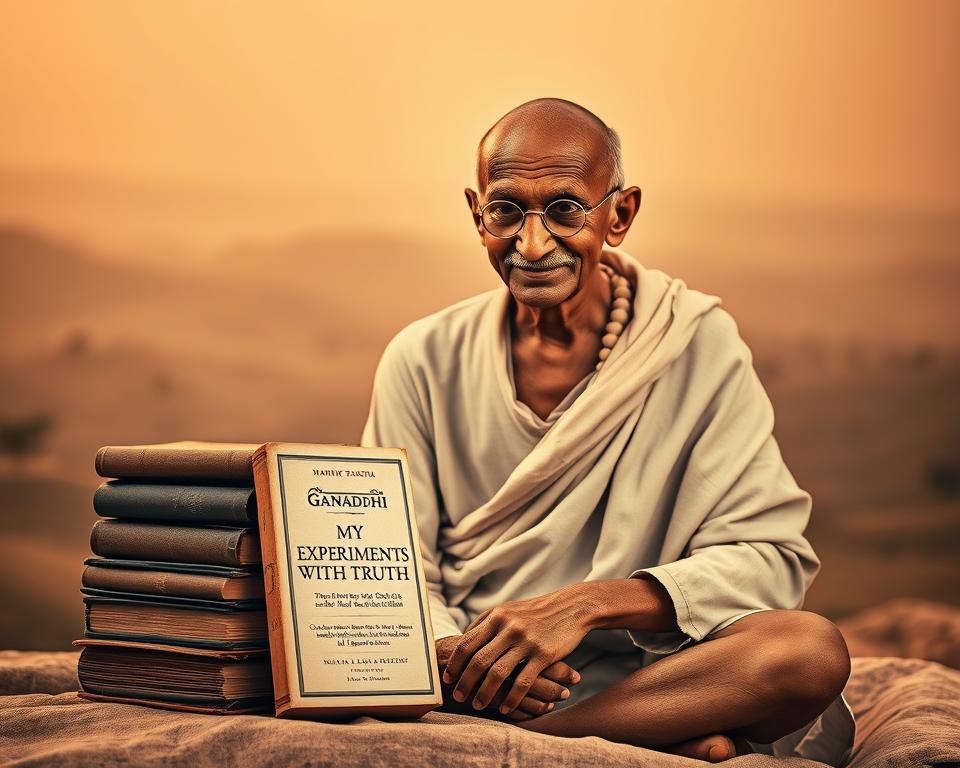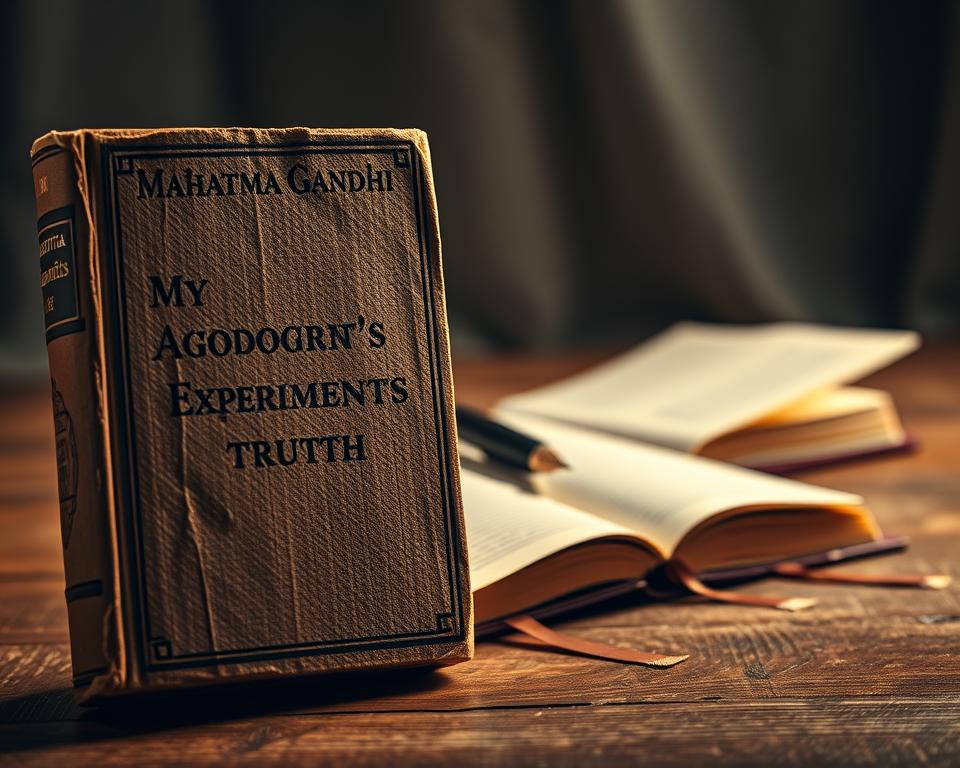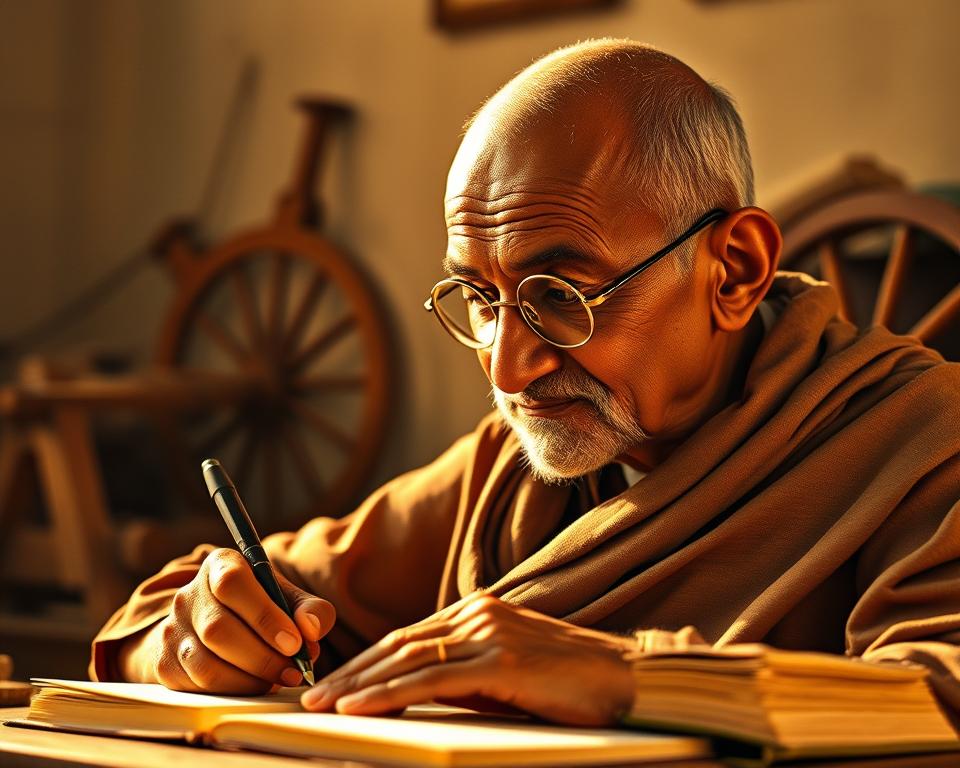Mahatma Gandhi’s autobiography, My Experiments with Truth, is a key piece of global thought. It was published in 166 parts in Navajivan from 1925 to 1929. This book shows Gandhi’s lifelong search for moral truth.
Over 50,000 copies of the Gujarati edition were sold, showing its quick impact. Written before its English release in two volumes (1927–1929), it tells of Gandhi’s vows during his London education. He vowed to avoid alcohol, meat, and carnal desires, shaping his path to India’s independence.
what do we learn from the book my experiments with truth? It shares Gandhi’s failures and triumphs, like his 1922 incitement charge and two-year imprisonment. It also talks about his life lessons on Satyagraha—truth-force—first declared in 1906.
His 21-year stay in South Africa, where he led the Indian Medical Corps during the Boer War, is highlighted. His marriage at 13 and his advocacy through the Natal Indian Congress show a man reshaping ethics amid colonialism.
Key Takeaways
- Core lessons on truthfulness and nonviolence as tools for social change.
- Gandhi’s early vows and experiments with celibacy, diet, and self-discipline.
- How his South Africa activism laid groundwork for India’s freedom struggle.
- Analysis of modern issues like racism and unethical financial pursuits through his lens.
- Emphasis on ethical service free from monetary motives, as seen in his refusal of rewards.
- Impact of silence and honest communication in resolving conflicts.
Introduction to Gandhi’s Autobiographical Journey
Mahatma Gandhi’s autobiography, My Experiments with Truth, shows his lifelong quest for ethical living. It was written from 1925 to 1928, focusing on personal growth over political wins. This journey takes us from a young lawyer in South Africa to a spiritual leader, highlighting both failures and triumphs.
Gandhi once stated, “Strength does not come from physical capacity. It comes from an indomitable will,” a theme central to his self-examination.
Gandhi wanted to share his truth-seeking methods by documenting his life up to 1920. He left out later events, like the 1930s salt march, to focus on key lessons. The book’s mix of introspection and activism shows his dual role as a reformer and mystic.
- Genesis: Began in South Africa (1893-1914) where he fought racial laws, shaping his satyagraha philosophy
- Purpose: To guide others through his moral experiments, not glorify achievements
- Context: Written during India’s independence struggle, yet centered on inner transformation over political tactics

The work blends Western autobiography with Indian spiritual stories. It was published in Gujarati, focusing on ethical questions like caste reforms and celibacy. It also tackles societal issues, like the struggles of indentured laborers, showing Gandhi’s impact on modern Indian thought.
The Structure and Style of Gandhi’s Masterpiece
I found that the mahatma gandhi autobiography is different from usual memoirs. It focuses on teaching ethics over telling a story in order. It’s divided into five parts, showing Gandhi’s journey with honesty and nonviolence.
His writing is simple and clear, aiming to reach everyone. Key features include:
- Self-critical honesty: He shares his mistakes, like smoking and visiting brothels when young.
- Blending stories with philosophy: He mixes tales from South Africa’s protests with deep thoughts on truth.
- Third-person narration during key moments, as if watching himself.
“To attain [perfection], one has to become absolutely passion-free in thought, speech and action,” he writes in the final chapter. This mantra underpins his life’s work, from fasting for purity to dismantling caste discrimination.

Every sentence shows his belief in living gandhi’s principles and values. The 1920s text is timeless because it offers a clear path to change. It shows that even with little money, one can make a big impact through disciplined living.
What Do We Learn from the Book My Experiments with Truth?
Gandhi’s My Experiments with Truth shows how his gandhi’s life lessons grew from daily battles. It’s not just a story; it’s a guide to living by gandhi’s principles and values. He shares both his failures and victories, teaching us to live truth, not just talk about it.
“Conquering subtle passions is harder than conquering the world by force.”—Mahatma Gandhi
- Power of Vows: Gandhi started by making public vows to be truthful, making him accountable.
- Speech as a Weapon: He learned self-control by staying silent for days, showing discipline begins with restraint.
- Ethics Over Comfort: Even when humiliated in South Africa, he chose moral integrity over comfort.
- Overcoming Fear: His journey from being timid to leading movements shows courage grows with each ethical choice.
- Love Over Lust: He vowed to be celibate after having four children, showing his commitment to spiritual goals.
Gandhi’s gandhi’s principles and values were key in his political actions. In South Africa, he turned racial injustices into lessons on nonviolent resistance. The book shows how ethical methods, like boycotts and marches, can bring about change. His self-purification led to a shift in societal norms.
Today, Gandhi’s work on truth is relevant beyond India’s freedom. His focus on mental discipline, like dietary trials, shows the importance of self-assessment. The book urges readers to see every decision as a chance to grow in honesty and courage.
Gandhi’s Pursuit of Truth as a Spiritual Practice
Exploring My Experiments with Truth shows Gandhi made truth-seeking a daily habit. His book shares how he lived satyagraha, truth-force, in everyday life. This included what he ate and how he interacted with others.
“One should perform their duty without attachment to outcomes.”—Bhagavad Gita, guiding Gandhi’s lifelong experiments.
Gandhi’s principles and values came from deep self-reflection. He learned early to resist meat, setting a moral path. Later, choosing to be vegetarian was more than a diet choice—it was a stand against harm.
His autobiography offers insights into how he lived truth. He saw every meal as a test of his commitment to truth.
For Gandhi, personal discipline was a fight for truth. He practiced:
- Voluntary fasting to control desires
- Celibacy after marriage to prioritize spiritual growth
- Public confession of failures to maintain accountability
Non-violence (ahimsa) was key to Gandhi’s truth-seeking. He believed violence, even against injustice, tainted truth. His boycotts of foreign cloth showed non-violent resistance in daily life, not just politics.
Gandhi’s spiritual practice was not about withdrawal but aligning every action with truth. His journey teaches us that seeking truth requires constant awareness in thought and action.
Lessons on Simplicity and Self-Reliance
Exploring My Experiments with Truth showed me gandhi’s life lessons on simplicity and self-reliance. This book is key to understanding his philosophy. It offers practical steps for moral and social change.
Gandhi’s transformation from a lawyer to a simple man was more than personal. It was a plan for changing society.
“The essence of non-violence is simplicity.”
His story of giving up luxury made me see how materialism blinds us. He believed having fewer things helps us see right from wrong more clearly. Gandhi chose khadi and village industries to fight against British control.
He also practiced farming and sanitation, rejecting old caste-based labor. This shows his commitment to equality and self-reliance.
- Reducing possessions to reduce dependency
- Community-based production to empower rural economies
- Physical labor as a form of equality
Today, Gandhi’s teachings question our consumer culture. The significance of my experiments with truth remains a guide for living ethically. His actions, from spinning to farming, prove self-reliance is a powerful tool for freedom.
Gandhi’s Approach to Diet, Health, and Celibacy
In My Experiments with Truth, Gandhi shares his views on diet and health. He started as a vegetarian in London, facing challenges from his peers. By 1906, he chose celibacy, seeing it as a way to keep his body and spirit pure.
Gandhi’s diet evolved over time. He ate at 5:30 PM, with a focus on sprouted wheat, veggies, and soya beans. In A Guide to Health, he said most health problems come from bad food choices. He believed in eating raw veggies, as they were full of vitamins.
His 1935 ashram menu was simple but nutritious. It included chapattis, tomatoes, and coconut. Gandhi showed that simple food can nourish both body and soul.
“It is the duty of every thoughtful Indian not to marry,” Gandhi declared, framing celibacy as a moral imperative. His 1906 vow of brahmacharya aimed to channel energy toward service. Yet his personal struggles—late-night vigils with young women to test his resolve—highlighted the tension between practice and principle.
Gandhi linked diet and celibacy to his fight for truth. He believed fasting and celibacy helped him stay focused. His choices were bold, but they showed his commitment to change society. Gandhi’s personal experiments helped India find freedom.
The Evolution of Gandhi’s Political Consciousness
Reading My Experiments with Truth shows Gandhi’s political awakening. His early belief in British fairness was shaken by racism and colonialism. His time in South Africa from 1893 to 1914 was key.
Being thrown off a train for refusing to move, denied hotel stays, and forced to remove his turban in court changed him. These experiences showed him the harsh reality of racial hierarchies.
A 1896 trip to India was a turning point. At a Queen Victoria diamond jubilee event, reciting Britain’s national anthem made him doubt colonial benevolence. This moment, detailed in his writings, shifted his allegiance from colonial loyalty to questioning imperial rule.
His experiments with nonviolent resistance began as he realized legal systems failed marginalized communities. During the Boer War, Gandhi organized an ambulance corps to support British troops. Yet, this service deepened his critique of colonialism.
He noted British soldiers’ indifference to Indian laborers’ plight, revealing the disconnect between imperial promises and reality. These insights from gandhi’s autobiography underscore how service to Empire paradoxically fueled his anti-colonial resolve.
The significance of my experiments with truth lies in its honest portrayal of gradual political awakening. It documents Gandhi’s shift from advocating loyalty to British institutions toward organizing mass movements. Key lessons include:
- Racial discrimination abroad exposed systemic injustice
- Colonial legal systems failed to protect colonized peoples
- Nonviolent resistance emerged from failed appeals to imperial morality
Understanding this evolution shows how personal experiences shaped India’s freedom struggle strategy. His autobiography remains a roadmap for leaders seeking systemic change through ethical self-reflection.
How Gandhi’s Autobiography Shaped the Indian Independence Movement
My Experiments with Truth is key to India’s fight for freedom. Gandhi’s gandhi’s principles and values changed politics into a moral fight. His weekly stories in Navajivan magazine from 1925 made his message clear to all.
- South Africa’s Lessons: Gandhi’s early fights, like the 1907 Satyagraha campaign, showed nonviolent resistance works.
- Moral Leadership: Gandhi’s honesty about his mistakes made him relatable. It showed his journey, not his perfection.
- Mass Mobilization: Stories like the 1917 Champaran protests showed how one person’s choice can lead to action.
The book’s 166 chapters focused on self-reliance, matching India’s needs. Its 1940 edition was affordable, reaching rural areas. It united people with a common moral goal.
Today, leaders use Gandhi’s significance of my experiments with truth to fight corruption and for justice. The book’s message of living truth inspires many. Gandhi’s words shaped India’s values of equality and secularism, showing his autobiography was more than a story—it was a call to action.
My Personal Reflections on Reading This Transformative Work
Reading My Experiments with Truth showed me how Gandhi’s teachings are relevant today. What do we learn from the book My Experiments with Truth? It teaches us that honesty begins with facing our own weaknesses. Gandhi shared his early struggles with truth, unlike today’s perfect social media images.
This openness inspired me to be more self-critical. It made me see the value in being honest about my flaws.
“The mind is not a vessel to be filled but a fire to be kindled.” – Gandhi
Gandhi’s autobiography teaches us that small choices shape our character. His childhood mistakes, like misspelling “kettle,” show that growth starts with admitting errors. His lack of interest in extra reading is common, but his later focus on moral experiments shows discipline can change our efforts.
Truthfulness is something we must practice every day. Gandhi’s experiments, like testing vegetarianism or truth-telling, are similar to today’s mindfulness practices. His journey shows how self-reflection can turn weaknesses into strengths.
For example, his repeated engagement with plays like Harishchandra shows the impact of stories on our values.
Today, Gandhi’s message of combining action with ethics is more important than ever. The book’s lessons on blending tradition with innovation are relevant to India’s social issues. After reading, I see every decision as an ethical experiment. This autobiography is not just history; it’s a guide for living honestly in today’s fast-paced world.
The Global Influence of Gandhi’s Principles and Values
Gandhi’s teachings on truth and nonviolence have spread across the world. His book, *My Experiments with Truth*, is a guide for leaders everywhere. It shows how his ideas are important globally.
“The significance of my experiments with truth lies not in perfection but in the relentless pursuit of justice,” Gandhi wrote. This ethos fueled civil rights struggles from the U.S. to South Africa.
- Martin Luther King Jr. modeled his protests after Gandhi’s satyagraha, citingting the autobiography as his “beacon during the Montgomery Bus Boycott.”
- Nelson Mandela credited Gandhi’s writings for guiding his anti-apartheid strategies during imprisonment.
- César Chávez’s farmworker campaigns mirrored Gandhi’s emphasis on moral persuasion over force.
Today, movements for climate justice and equality follow Gandhi’s lead. His book’s message is clear: change starts with personal growth. Gandhi’s teachings inspire people worldwide, from India’s farmers to global climate activists.
Critiques and Controversies: A Balanced Assessment
Reading mahatma gandhi autobiography makes us think about his lasting impact and its limits. Critics point out missing parts in insights from gandhi’s autobiography about personal life and social issues. For example, Gandhi didn’t share Kasturba’s view on their marriage, hiding the gender issues of his time.
“Where there is only a choice between cowardice and violence, I would advise violence,” Gandhi wrote in 1920, revealing contradictions in his philosophy. Such statements contrast with later advocacy for non-violence, sparking debates about consistency.
- Personal controversies include his experimental practices like sleeping near young women to test celibacy (brahmacharya), which modern readers find ethically problematic.
- Political critiques argue his non-violent methods delayed India’s freedom, as seen in the 1942 Quit India Movement’s violent crackdown by British forces.
- Racial blind spots emerged in his South African writings, where he initially referred to Africans as “kaffirs” before advocating for Indian rights.
- Feminist scholars note his emphasis on women’s “self-restraint” reinforced patriarchal norms despite his fight against colonialism.
George Orwell’s 1949 essay Reflections on Gandhi praised Gandhi’s moral courage but doubted its use against totalitarians. Orwell said non-violence might not work without civil rights. These debates are important today as insights from gandhi’s autobiography show both his vision and historical flaws. By looking at these critiques, we get a better understanding of Gandhi’s humanity and the complexity of his legacy.
Conclusion: The Enduring Significance of My Experiments with Truth
“My Experiments with Truth” shows how Gandhi’s teachings are key to solving today’s problems. His life story is a guide for mixing personal values with group efforts. It teaches us that growing as an individual can lead to big changes in society.
The Salt Satyagraha in 1930 is a perfect example. It showed Gandhi’s belief in truth and nonviolence in action. This movement inspired many, from the U.S. civil rights to South Africa’s fight against apartheid.
Gandhi taught us to never give up and to stay humble. He learned from his mistakes, showing us the value of trying and failing. His ideas about self-reliance and equality are important today, in India’s fight against caste and environmental issues.
His book has been translated into over 30 languages and is studied in 50 countries. It’s a message for all, in our digital world and political divisions. Gandhi’s message to “be the change” is powerful. His legacy, like the 2 million who joined the Salt March, shows that standing up for what’s right can change the world.





